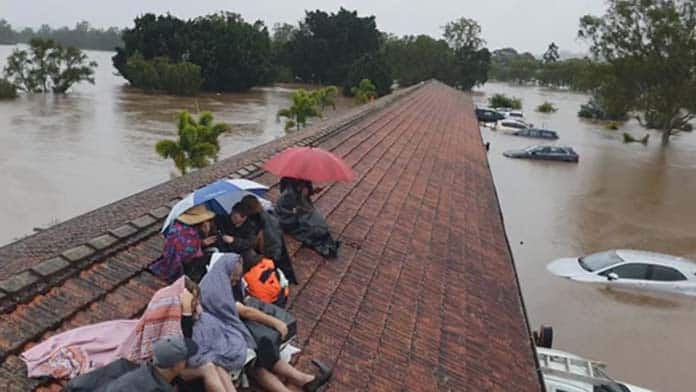Maeve Larkins reviews a new book by Marxist writer Alex Callinicos that analyses the succession of crises facing the world—and the prospects for catastrophe and revolt
Humanity faces several intersecting crises: Worsening global warming, pandemic, superpower rivalry between the US and China, an increasingly fragile global economy, and the return of the far right.
These crises each exacerbate the others. Alex Callinicos’s new book The New Age of Catastrophe sets out to show how capitalism as an economic and social system is responsible for this new age of catastrophe.
Despite this bleak picture, he points to the recent eruptions of mass movements like Black Lives Matter as a source of hope. As Callinicos writes, “The age of catastrophe is also an age of revolt, and therein lies our hope for the future.”
It is a valuable book for anyone seeking to understand the current state of the world, and what can be done to avoid disaster.
The prospect of catastrophe is nowhere more clear than with climate change, which is already causing more frequent fires, floods and other disasters. Accelerating, runaway climate change poses a real threat of worldwide “starvation, destruction, migration, disease and war”.
As Callinicos writes, it is crucial that we understand the climate crisis as a product of capitalism. Competition between firms means there is a “pressure to minimize costs … encourag[ing] firms to focus on whatever measures will bring profitability”.
Any business that takes on higher costs to safeguard nature won’t be able to compete. A complete transition away from fossil fuels would also force companies to write off trillions of dollars of fossil fuel investments—threatening vast wealth.
Increasingly, states have begun to encourage a transition to renewable energy.
However imperialist rivalries prevent a transition on the scale and speed necessary, because any state that imposes the costs involved on its economy “will be disadvantaged in comparison to their rivals elsewhere.”
Imperialism
In recent years there has been a global military buildup unlike anything since the Second World War. The war in Ukraine has led to an estimated 100,000 deaths. The US has committed around $75 billion aid to Ukraine, the vast bulk of it for Ukraine’s military.
But the bigger contest is between the US and China, which are increasingly locked in both economic and military competition. There is a real prospect of war over Taiwan. China hopes to eventually push the US military back from the Indo-Pacific, which has become “the main hub of global capitalism, representing about 40 per cent of global GDP.”
Callinicos argues that the war in Ukraine must be understood in this context. The US bankrolling of the Ukrainian military, in a proxy war against Russia, is a warning to China that any invasion of Taiwan would come at an enormous cost—both militarily and in financial sanctions such as those used against Russia.
The war has also served to shore up US military alliances, particularly with the EU.
Germany, for instance, has pledged $100 billion to upgrade its military. All the across the EU, and other US allies like Japan, the war in Ukraine has led to substantial increases in military spending.
On the other hand, only the US’s core allies have supported economic sanctions against Russia. Significant economies including India, South Africa and Brazil, along with China and most of the Global South, have refused. The shows how the world threatens to divide into rival economic blocs.
Among the advantages the US has over China its dominance of technology industries. The US has sought to protect this technological edge by denying China access to advanced semiconductor chips made with US equipment, and “to block Beijing’s plans to upgrade its industries from low-wage manufacturing final assembly to hi-tech”.
These industries also include “the new products crucial to a capitalism that adapts to climate change.”
Economic crisis
Underlying the imperialist tensions is China’s economic growth in the face of the US stagnation.
Since the 1980s, there has been a succession of economic crises including the 1997 Asian financial crisis, the 2001 dotcom bubble, the 2007 Global Financial Crisis, and the crisis caused by the pandemic in 2020.
Underlying this is the decline in profit rates since the end of the post-war boom in the 1970s.
The neoliberal economic policies implemented globally were a response to this, “forcing up the rate of exploitation through an offensive against organized labour”.
In Australia, this involved the Hawke-Keating Labor governments of the 1980s restraining strikes and eroding trade union organisation, culminating in the system of enterprise bargaining which has enormously constrained strike action.
But this has failed to completely restore capitalist profitability.
More recently the US economy has relied on a series of financial bubbles which, Callinicos writes, “acted, in the absence of a robust recovery of the rate of profit, as a mechanism for stimulating effective demand.” Debt and credit have become crucial to driving economic growth.
But the problem with financial bubbles is that they inevitably burst.
This has led to a fragile global economy, where a major shock to the system threatens to collapse the enormous mountains of debt. Callinicos discusses how one major effect of this has been for states to increasingly rely on central banks and direct state intervention for crisis management.
Protecting “too-big-to-fail” mega-corporations and banks from collapsing has also created immense dead-weights in the global economy. This is also a problem for China, as the Evergrande crisis of 2021 shows.
The far right
Callinicos also discusses how economic stagnation is causing widespread disillusionment in the establishment parties of capitalism. Worsening inequality and austerity has produced discontent that has been exploited by far-right populists like Donald Trump in the US and Georgia Meloni in Italy. The figures scapegoat refugees, migrants, and LGBTIQ people for the crises facing the working class.
However, Callinicos draws a distinction between parties or leaders such as Meloni who enjoy mainstream electoral success today and classical fascist organizations.
Today’s far right do not possess mass paramilitary organisations that could be mobilised against trade unions, refugees or other minorities. Nor do capitalists face the existential threat of workers’ revolution as they did in the 1920s and 1930s that made them willing to hand state control to violent fascist parties.
But the success of far-right populism has led to what Callinicos calls a “blurring” of “the boundaries between mainstream conservative, populist-racist, and outright fascist formations” which has led to “populist radical right (and even some extreme right) ideas [being] openly debated in mainstream circles”.
As a consequence, harder far right and fascist organisations have a chance to grow.
The pandemic provided an indication of the way the far right could seek to capitalise on catastrophe. In Australia as elsewhere, the far right sought to organise within the anti-lockdown “freedom movement”.
This was bolstered by the majority of the left giving uncritical support to punitive lockdown measures, such as curfews or workplace vaccine mandates. These were particularly weaponised against migrant communities, in an effort to use racist scapegoating to distract from the government’s mismanagement of the pandemic and under-funded hospitals and health infrastructure unfit for an adequate health response.
The result was that the far right was able to capitalise on the discontent about lockdowns unchallenged. While there is little evidence that fascist organisations grew substantially as a result, far right activists have flowed into recent actions against trans rights and Drag Queen story events in Melbourne.
As the intersecting crises worsen and intensify, there is a danger the far right will become a more serious threat.
Social movements
Callinicos counterposes the rise of the right with the simultaneous emergence of mass movements against social oppressions like racism in the Black Lives Matter (BLM) protests of 2020.
At its highest point, BLM produced thousands of protests across the US against police violence and racism.
The BLM uprising of 2020 was the largest protest movement in US history and inspired anti-racist struggles across the world.
Callinicos argues that a major backdrop to BLM was the disproportionate devastation that the pandemic had on Black communities, alongside the growing dominance of insecure employment. As a consequence, BLM took on a wider political significance, with the potential to target not only police brutality, but issues of precarious labour and housing insecurity.
Callinicos argues that there is therefore a potential for movements like BLM to link with labour movements, and in doing so, push trade unions into broader political action. Workers’ strike action would also provide these social movements with much greater power, through the ability to shut down the flow of capitalist profits.
A major factor behind the far right’s ability to benefit from rising discontent has been, Callinicos writes, “The large-scale failure of mainstream social-democratic parties and trade unions to resist austerity.”
The withering of the strength of working class organisation and militancy as a product of the neoliberal assault has led to an increase in bureaucratisation, and to union leaders becoming further integrated into establishment parties.
The uptick of workers’ strikes we have seen following the pandemic in France, the UK and the US shows that workers are still capable of mass resistance. A revival in working class militancy will be vital to ensuing the polycrisis facing the world does not end in disaster.
The effect of worsening climate crises, deepening austerity, and widening inequality is creating a situation where “Growing numbers of people are confronted with drastic deterioration in their material conditions… at the same time the dominant elites are discredited both as a result of their mismanagement of the situation and because they give priority to protecting and enriching themselves.”
The crises that threaten to devastate us also provide the possibility of mass resistance and revolution.
The New Age of Catastrophe
By Alex Callinicos
Polity, $38






